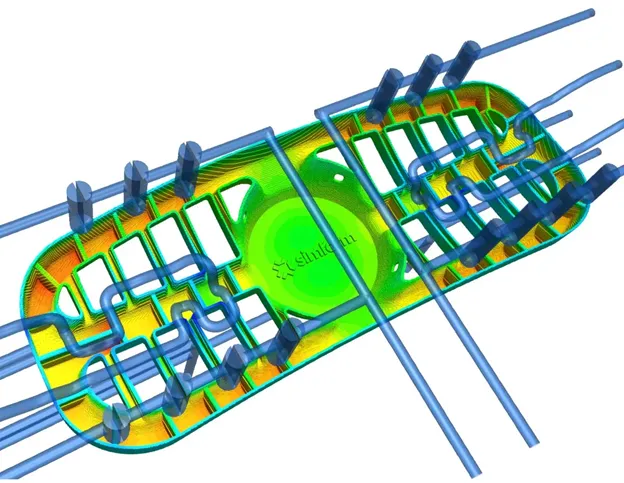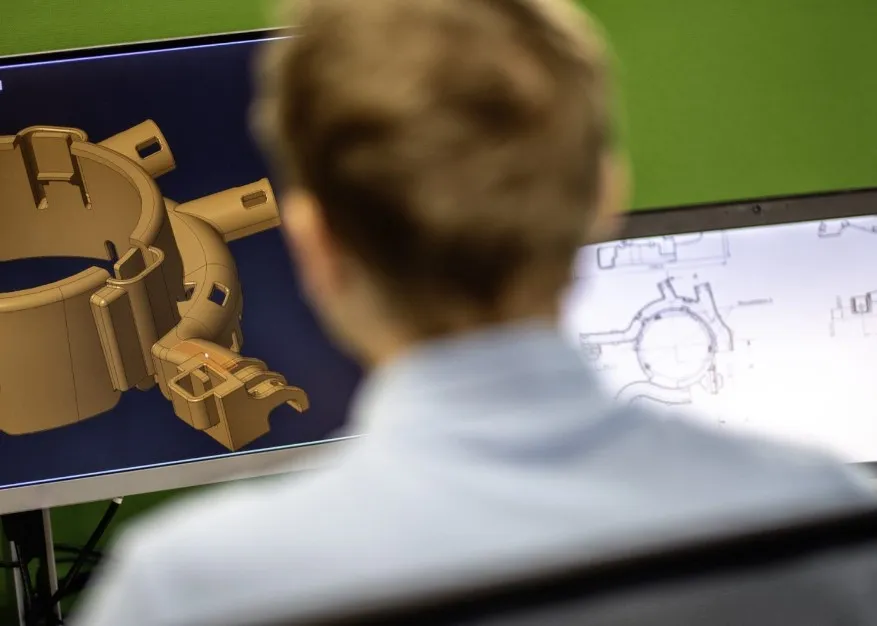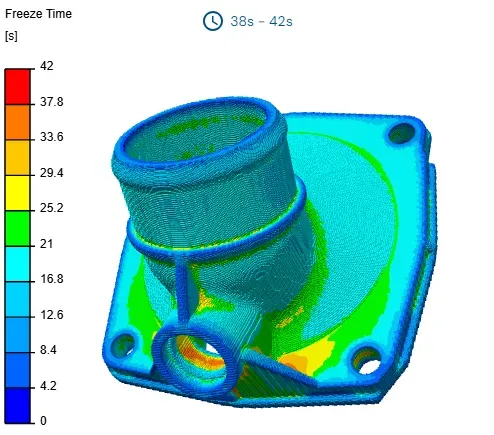by Arnaud Divialle
Conformal cooling solutions promise to greatly improve part quality, cycle times and energy efficiency in plastic injection and compression molding.
But are the benefits worth the added costs?
The benefits of conformal cooling

Conformal cooling channels deliver fast, uniform cooling, which translates into shorter cycle times, better quality parts, and more profitability.
The benefits of conformal cooling include:
- Lower operational costs & energy consumption
- Fewer common defects
- Reduced material cost and waste
- Improved design flexibility
- Improved heat transfer efficiency
Reduced cycle time
In plastic compression and injection molding, as much as 80% of the total cycle time is devoted to cooling, especially for complex parts. Conformal cooling channels transfer heat more efficiently. As a result, parts cool quicker, making the overall cycle time significantly shorter – in some cases by 30% to 50% – compared to traditional molds. For the molder, this means reduced operating costs and increased production capacity.
Improved part quality
By providing more uniform cooling across the part and the mold, conformal cooling minimizes common defects, such as warpage, shrinkage, and sink marks.
Parts molded using conformal cooling often have a better surface finish and less internal stress. This leads to a better dimensional accuracy and lower scrap rate, reducing material costs and waste for an added environmental and financial benefit.
If your parts have tight dimensional tolerances or sensitive cosmetic features, conformal cooling often provides a more predictable outcome. The difference in surface quality and consistency helps in sensitive industries like medical, aerospace, and electronics, quality can’t be compromised.
A conformal approach also helps to reduce that familiar trial-and-error loop during initial mold trials. More uniform cooling and less variability means teams can get to first acceptable part faster. You’re effectively saving both material and labor during mold validation.
Energy efficiency
Shorter cooling times and optimized thermal management can reduce energy consumption. Plus, conformal cooling lines tend to be shorter and smoother with lower pressure drops. Lower pressure drops need smaller pumps, reducing capital expenditure. As injection molding machines often operate continuously, less time spent cooling each cycle means lower operational costs and more energy savings.
Energy bills are a major line item in many plants. A faster cycle time — even if it’s only by a few seconds per shot — can turn into large savings over the course of a production run. Multiply that across multi-cavity molds or multiple presses, and the initial investment becomes easier to make.
There’s also a sustainability angle to consider. Less energy per part means a smaller carbon footprint, which is valuable for manufacturers looking to meet internal ESG goals or customer demands around sustainability.
Potential limitations of conformal cooling vs. conventional cooling

The potential competitive advantage is too good to ignore. But it comes at a cost.
Conformal cooling requires more upfront investment, from higher initial tooling costs to more complex designs, which in turn drive up engineering costs and lead times.
Plus, conformal cooling inserts are more challenging to maintain and repair and may not be suitable for as wide a range of materials as traditional methods.
Design complexity
Designing conformal cooling channels in compression and injection molding requires advanced software, simulation tools, and skilled engineers who will need to spend more time designing an efficient cooling layout. The complexity of these designs can increase engineering cost and lead times.
Designers often need access to specialized knowledge of additive manufacturing constraints, too. What can be designed in CAD may not always be feasible or cost-effective to print. Teams must work closely with their AM suppliers to ensure printability and durability.
Maintenance and repair
Conformal cooling molds are more difficult to maintain and repair than traditional molds. The complex 3D channels can be harder to clean, and buildup or clogging ("scaling") within these channels can hinder performance. And, if a conformal cooling channel is damaged, repairs and modifications are likely to be more complicated and expensive due to the custom design and additive manufacturing process.
Preventive maintenance plans need to be rethought. Many shops are used to rod cleaning or flushing drilled water lines with standard chemicals. Those routines may not work well for long, curved internal channels that aren’t easy to access.
Designers must also anticipate thermal fatigue over time, especially if the selected alloy doesn't handle heat cycles as well as hardened tool steel.
Limited material options
Conformal cooling molds are typically made using metal alloys compatible with 3D printing technologies. But, there is a more limited range of materials available for additive manufacturing than for traditional mold-making methods, where hardened tool steels may be used for greater durability. In industries that use abrasive materials or high temperatures, 3D-printed materials may not offer the same longevity as conventionally machined tool steels.
As a result, not every shop is set up to take full advantage of 3D printed conformal cooling designs. Teams have to take time, first, to evaluate whether their existing press equipment, resin types, and expected production volumes align with the thermal and mechanical performance limits of 3D-printed mold inserts.
Some hybrid designs — where only select inserts are printed with conformal lines, while the rest of the mold is built traditionally — can offer a middle ground that preserves durability while still gaining some performance benefits.
Weighing the pros and cons of conformal cooling

Knowing when it makes sense to spend on conformal cooling – and when it doesn’t – is key.
It’s worth taking the time to carefully evaluate the pros and cons of conformal cooling for your specific situation before making the decision to move ahead or not.
The best time to consider conformal cooling is during early mold design or even quoting. That’s when there’s still flexibility to adjust part geometry or mold layout to accommodate curved channels. Late-stage changes or retrofits are rarely cost-effective.
Conformal cooling is often best suited for parts with long cycle times, hard-to-reach hot spots, or known cosmetic sensitivity. For high-volume runs or parts where cycle time is a competitive factor, the ROI may justify the extra tooling cost.
SimForm’s Conformal Cooling ROI Calculator eliminates the guesswork for you
The Conformal Cooling ROI Calculator
Find out quickly and easily whether conformal cooling is right for your plastic injection molding application.
Simply input basic information about your mold specifications and production parameters to get your analysis.
Make the best cooling decisions for your specific plastic injection molding needs. Even if you’re just exploring whether to invest in additive manufacturing or hybrid tooling strategies, the calculator helps benchmark potential gains before spending on full analysis.